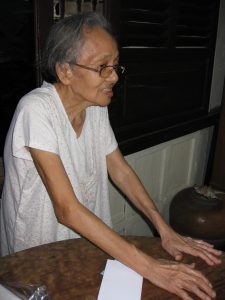
Hand weaving is a centuries-old legacy of Iloilo reputed to date back to the pre-colonial period. The Spaniards at the time of their colonial administration chanced on Ilonggas who were adept in hand-weaving textiles. By the 19th century, with the refinement process and the European style embroidery introduced by the Spaniards, the textile production of Iloilo gained national prominence in its remarkable degree of advancement. It earned for Iloilo the title of “Textile Center” of the Philippines.
Ironically however, by the end of the 19th century when Iloilo became a sugar producing center in the region, the interest and much needed financial capital of business entrepreneurs shifted from weaving textiles to sugar production. Another blow to the textile industry of Iloilo was the introduction of cheap, imported English cotton materials which eventually diminished the local market for Iloilo’s prized textiles.
The eventual demise of what was once the country’s celebrated Iloilo textile industry soon became a sad reality by the 20th century. Thanks goodness for people like Mrs. Cecilia Gison Villanueva who, through the long years, has persevered to preserve Iloilo’s pride — sinamay and piña, hand-woven organic fabrics made from pure abaca and pineapple fibers which are remarkable for their ethereal quality and strength despite their seeming delicateness.
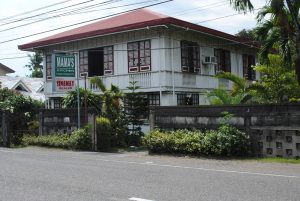
My visiting friend from Spain, Dr. Pablo Prados, cannot help but admire Arevalo’s weavers when he said, “With their crude and almost primitive looms and devices, it is really a wonder that they can produce such amazing products. The piña cloths can truly match the delicate texture of the spider’s web. Yet, from a European’s point of view, the amount of time and exacting labor spent in producing these wonderful and unique Filipino textiles are what makes sinamay and piña fabrics truly priceless.”
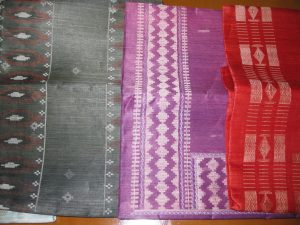
Iloilo’s Treasure
The Arevalo Sinamay Weaving Center is owned by Mrs. Cecilia Gison Villanueva which is located in her old ancestral house. Situated a few meters away from the Arevalo plaza, the Arevalo Sinamay Weaving Center is along Osmeña Street leading to the town of Oton. Occupying an area of 1000 square meters, the ancestral house was once occupied by the Americans during the Filipino-American war. In the 1950’s, First Lady Luz Banzon Magsaysay, the wife of President Ramon Magsaysay, dropped by the Villanueva’s Sinamay Weaving Center to buy some woven materials for her family. In the 1990’s, First Lady Ming Ramos, herself an Ilongga, was a special business patron of Mrs. Villanueva as well.
“The sinamay business was actually established by my great grandfather, Capitan Victorino Chavez, in the late 19th century. The weaving was done in this house during that time. Capitan Victorino handed down this house and the weaving business to his son, Cornelio. Later, my mother Rosario Chavez Gison inherited the property and business from my lolo Cornelio. I am truly proud that this humble home industry has managed to survive to this day. It is the Chavez family tradition for generations that I have in my own hands now,” the friendly and charming Ilongga confides.
Mrs. Villanueva laments the fact that it is difficult to interest the younger generation of Ilonggos to this traditional craft for the skill to be learned and passed on for future generations. Weaving requires patience, hard work, passion and commitment. Qualities which are truly lacking in today’s confused and materialistic MTV generation.
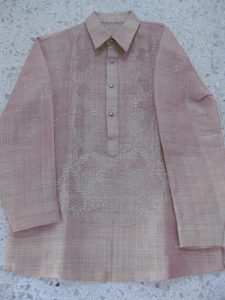
Mrs. Villanueva trusts and relies on her aging sinamay and piña weavers of decades for demonstrations in the Villanueva’s Sinamay Weaving Center whenever she is requested by Iloilo visitors. “It helps clients value our sinamay and piña products better if they see with their own eyes the actual weaving process. It is true art in itself,” she confided.
Mrs. Villanueva’s products consist of sinamay and piña clothing materials for wedding gowns and barongs; shawls and hankies; dining accessories like tablecloths and napkins; and fans, embroidered caftans, coin purses and bags. She has now included Iloilo’s popular hablon materials among her products which she sells to clients in Iloilo and Manila.
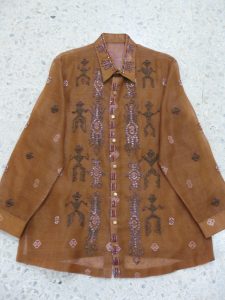
Thanks to persevering and entrepreneurial people like Mrs. Cecilia Gison Villanueva who has managed to preserve a national treasure in our sinamay and piña textiles. The Philippines, to date, is the only country in the world which has maintained her ancient tradition for producing hand woven textiles from abaca and pineapple fibers. The problem is, a majority of Filipinos cannot even afford to wear them with pride!
Madamo guid nga salamat, tita Cecilia, for being so accommodating and keeping the centuries-old Philippine tradition alive. It is always an honor to write about you and your beautiful sinamay and piña fabrics. My best regards to all the manang weavers.


